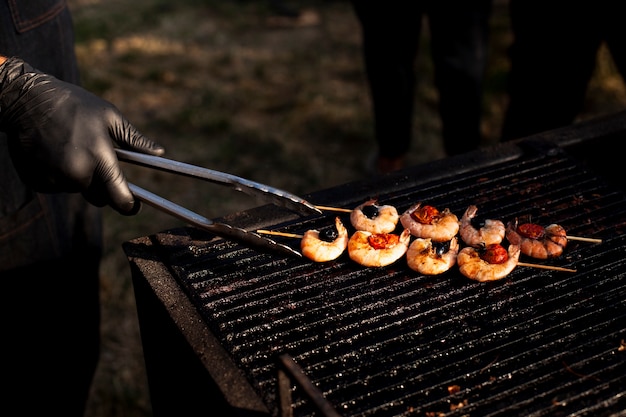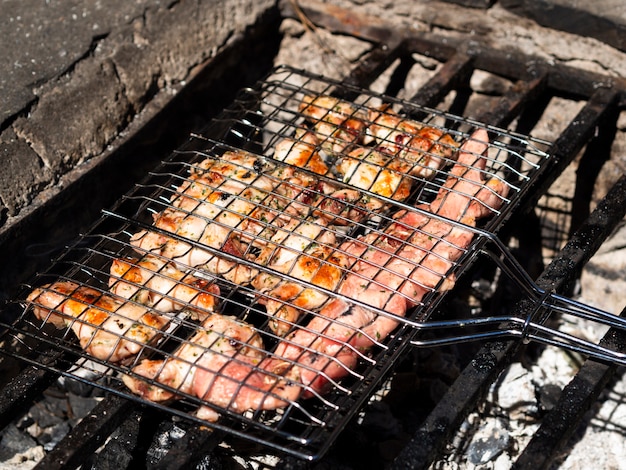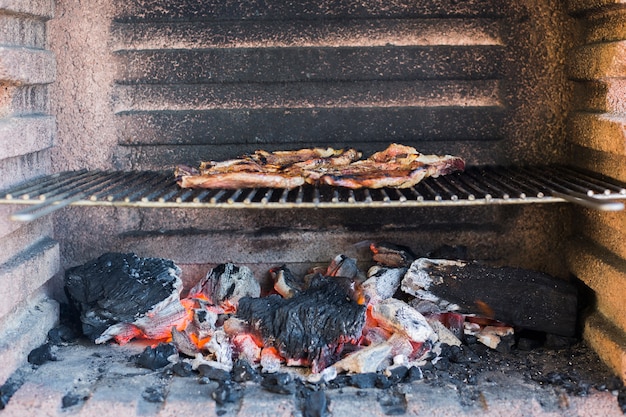How do you cook indirect heat on a Weber charcoal grill?
If you love outdoor cooking, then owning a Weber charcoal grill is a must-have. These grills are known for their versatility and ability to deliver that authentic smoky flavor to your meals. One of the key techniques to master on a Weber charcoal grill is cooking with indirect heat, which allows you to slow-cook large cuts of meat or delicate ingredients without burning them.
What is indirect heat?
When cooking with indirect heat, you create a two-zone fire in your grill. One side of the grill has the charcoal arranged directly under the food, providing direct heat for searing or quick cooking. The other side of the grill is left empty or has fewer coals, creating an indirect heat zone that allows for slower, more gentle cooking.
Why cook with indirect heat?
The indirect heat method is ideal for larger cuts of meat, such as roasts or whole chickens, as it allows them to cook evenly and slowly. This technique also works well for delicate foods like fish or vegetables that can easily overcook or fall apart when exposed to direct heat.
Cooking with indirect heat on a Weber charcoal grill ensures that your food retains its natural juices and flavors while developing a beautiful smoky taste. It also gives you better control over the cooking process, allowing you to achieve that perfect level of tenderness and doneness.
How to set up an indirect heat zone on a Weber charcoal grill?
Setting up an indirect heat zone is relatively simple with a Weber charcoal grill. Here’s how you can do it:
- Start by arranging the charcoal briquettes on one side of the grill, leaving the other side empty or with fewer coals.
- If you’re using a kettle-style Weber grill, open the bottom and top vents to allow for proper airflow.
- Light the charcoal using either a chimney starter or lighter cubes.
- Once the coals are lit and covered in gray ash, use long-handled tongs to spread them out evenly on one side of the grill.
- Place a drip pan filled with water or marinade on the empty side of the grill. This helps in maintaining moisture and prevents flare-ups.
- Put the cooking grate back in place, close the lid, and preheat the grill for about 10-15 minutes.
Tips for cooking with indirect heat
To make the most out of your cooking experience with indirect heat on a Weber charcoal grill, consider the following tips:
- Use a digital meat thermometer: This ensures that your meat is cooked to the desired temperature, eliminating the guesswork.
- Add smoking wood chips: For an extra layer of flavor, soak wood chips in water and then scatter them over the hot coals just before adding your food.
- Keep the lid closed: Opening the grill frequently can cause temperature fluctuations and extend the cooking time. Trust the process and resist the temptation to peek too often.
- Rotate the food: If you notice uneven cooking, rotate the food halfway through the cooking process to ensure even heat distribution.
“Indirect heat cooking on a Weber charcoal grill unlocks a whole new world of flavors. The slow and gentle heat allows the natural juices to infuse the food, resulting in tender and succulent dishes.”
With a little practice, cooking with indirect heat on a Weber charcoal grill will become second nature to you. Get creative with different recipes and enjoy the delicious results that this versatile cooking method can offer. Whether you’re hosting a backyard BBQ or simply enjoying a family meal, the smoky flavors and tender textures will be sure to impress.
Do you open or close the bottom of a charcoal grill?
When it comes to using a charcoal grill, there can be some confusion about whether to open or close the bottom vents. The answer depends on what you are trying to achieve with your grilling.
Opening the Bottom Vents:
If you want to increase the heat of your charcoal grill, opening the bottom vents is the way to go. By allowing more oxygen into the grill, the fire will burn hotter and faster, giving you a higher cooking temperature. This is ideal for cooking thicker cuts of meat that require searing or charring on the outside while remaining juicy on the inside.
Pro tip: If you’re using a chimney starter to light your charcoal, leaving the bottom vents open will help the coals ignite and burn more quickly.
Closing the Bottom Vents:
On the other hand, closing the bottom vents is useful when you want to lower the cooking temperature or create a longer cooking time. By restricting the airflow, you reduce the amount of oxygen available to the fire, resulting in a slower and cooler burn. This method is ideal for cooking delicate foods or when you want to achieve a slow-smoked flavor.
Pro tip: Closing the bottom vents can also help you control flare-ups and prevent the fire from getting too hot.
Remember, every grill is different, so it’s important to experiment and find what works best for your specific grill and cooking style.
Here’s a handy table summarizing the effects of opening or closing the bottom vents:
| Vent Position | Effects |
|---|---|
| Open | Increases heat |
| Close | Decreases heat |
To conclude, whether you open or close the bottom vents of your charcoal grill depends on your desired cooking temperature and style. Remember to consider the type of food you’re grilling and adjust the vents accordingly for the best results.
What Does Putting the Lid on a Charcoal Grill Do?
When it comes to grilling, many people wonder why they should bother putting the lid on their charcoal grill. Is it simply a preference or does it actually serve a purpose? Let’s dive into the reasons why putting the lid on a charcoal grill is essential for the best grilling experience.
1. Retaining Heat and Controlling Temperature
One of the key benefits of using the lid on a charcoal grill is that it helps to retain heat and control the temperature. By trapping the hot air inside the grill, the lid creates an oven-like environment, allowing your food to cook evenly from all sides. This is especially important when grilling larger cuts of meat or items that require longer cooking times.
2. Enhancing Flavors and Juiciness
Another advantage of using the lid is that it helps to lock in the smoky flavors produced by the charcoal. The lid prevents these flavors from escaping, resulting in a more robust and flavorful grilled dish. Additionally, keeping the lid on helps to retain moisture, preventing your food from drying out and ensuring that it stays juicy and tender.
3. Preventing Flare-Ups and Controlling Flames
Using the lid on a charcoal grill can also help prevent flare-ups and control flames. The lid acts as a shield, minimizing the oxygen flow to the burning charcoal and reducing the chances of sudden bursts of flames. This is particularly useful when grilling fatty meats or when using marinades or sauces that may cause flare-ups.
4. Protecting against External Factors
Putting the lid on your charcoal grill provides protection against external factors such as wind, rain, or debris. The lid acts as a shield, preventing these elements from affecting the cooking process or potentially extinguishing the charcoal. It helps maintain a consistent cooking environment, allowing you to grill regardless of the weather conditions.
Using the lid on a charcoal grill is not just a preference; it plays a crucial role in achieving delicious and perfectly cooked meals.
So, next time you fire up your charcoal grill, make sure to put the lid on and reap the benefits of enhanced flavors, controlled temperatures, and protected cooking environment. Happy grilling!
How do you keep a charcoal grill hot while cooking?
1. Start with the right amount of charcoal
To keep your charcoal grill hot while cooking, it’s important to start with the right amount of charcoal. Whether you’re using briquettes or lump charcoal, use enough to create an even layer across the bottom of your grill. This will ensure a consistent heat source throughout the cooking process.
2. Use proper ventilation
Ventilation plays a crucial role in maintaining a hot charcoal grill. By adjusting the vents on your grill, you can control the amount of oxygen that reaches the coals. Opening the vents will allow more oxygen in, increasing the heat, while closing them will reduce the airflow and lower the temperature. Finding the right balance will help you maintain the desired level of heat.
3. Arrange the charcoal for direct and indirect heat
When cooking on a charcoal grill, it’s common to use both direct and indirect heat. Direct heat is ideal for searing and quickly cooking foods, while indirect heat is perfect for slow cooking and smoking. Arrange your charcoal accordingly by stacking it on one side for indirect heat and spreading it evenly for direct heat.
4. Monitor and adjust the charcoal as needed
Throughout the cooking process, it’s important to monitor the temperature of your charcoal grill. If the heat is dropping, add more charcoal to maintain the desired heat level. Conversely, if it’s getting too hot, remove some of the lit coals or close the vents partially to reduce the airflow.
5. Preheat your cooking surface
Before placing your food on the grill, make sure to preheat the cooking surface. This will help to prevent sticking and ensure even cooking. Allow the charcoal to burn for about 10-15 minutes before placing your food on the grill.
Pro tip: Create different temperature zones on your charcoal grill by placing more charcoal on one side for higher heat and less charcoal on the other side for lower heat. This will give you more flexibility in cooking different types of foods simultaneously.
By following these tips, you can keep your charcoal grill hot while cooking, allowing you to achieve delicious and perfectly cooked meals.



